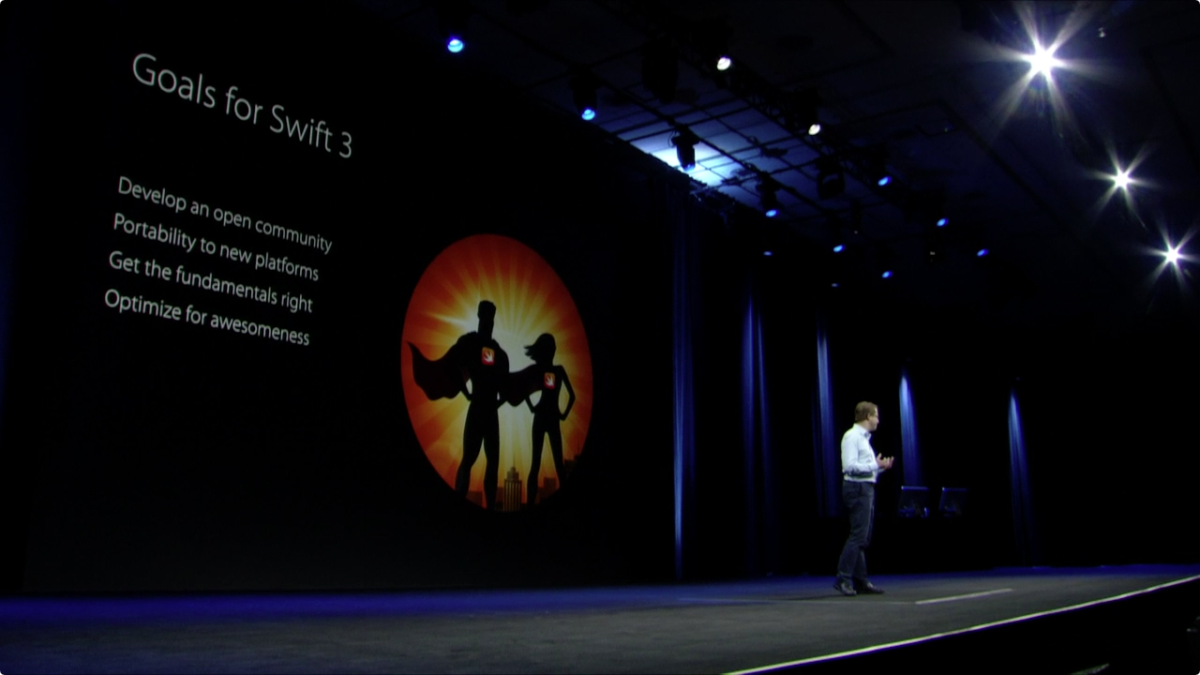I just finished watching What’s New in Swift from WWDC 2016 and wanted to pass on the highlights for you. “What’s New in Swift” is great session that I highly recommend you also watch for yourself. There are a couple things that jump out at me that I feel are worth writing about.
Goals For Swift 3
Unless you’re hiding under a rock, you’ll know that the big news in Swift is the upcoming release of Swift 3. This presentation kicks off immediately covering the goals for Swift 3:
- Develop an open community
- Portability to new platforms
- Get core fundamentals into shape
- Optimize Swift for awesomeness
Granted some of these are a little “soft” and not well defined, I really like the first goal. On stage, Apple did not hold back in describing that Swift 3 will be the result of total community involvement with the languages evolution – which is exactly the desired intention. This totally hits home for me. Even though I haven’t been an active participant in the language’s evolution, I’m a firm believer that the open source software model leads to better software, and for something as critical as the language that I could be using for the foreseeable future, I’m happy that it’s being evolved in such an open model.
Swift Adoption at Apple
This might be one of the first times that I’ve seen or heard Apple formally recognize and describe major uses of Swift internally in their own development. It was surprisingly extensive, and refreshing to hear them actually admit to it. Swift has been out almost two years now, and for me, one of the signs I’ve been looking for to represent Swift’s maturity is precisely this: Apple’s adoption of the language in their own products, and they finally hit the nail on the head for me. Here are some highlights:
Apple Products With Lots Of Swift
- New Music app for iOS
- Console app in Sierra
- Dock app
- Picture in Picture in Sierra (actually 100% Swift)
- New documentation viewer in Xcode (actually 100% Swift)
- Swift Playgrounds for iOS (actually 100% Swift)
The presenter then went on to talk further about the Dock with some really revealing information. Internally, there’s actually a lot of stuff I consider general “OS functionality” that Apple actually classifies as the Dock app. Can you believe all this is included in the Dock codebase?
- Dock bar at the bottom
- Mission Control
- Command-Tab Application Switcher
- Stacks
- LaunchPad
- Spaces
- Dashboard
- Some of Notification System
What’s interesting about the Dock app is that a significant amount of Swift code was written for it in the El Capitan release, 10s of thousand lines of Swift code out of a total of 200k lines of code total. This is interesting because it represents a case study of a non-trivial amount of code that will be migrated from Swift 2.2 to Swift 3.0, and Apple did just this. The migration resulted with about 15% less actual code! Not to mention that the engineers like the safety features of Swift as well as the more articulate code.
How To Contribute To Swift
Have you seen swift.org yet? It’s the home of Swift on the web, besides the actual repositories on GitHub. There is a ton of information on the site about everything from migrating to Swift 3, to information on how to get started with contributing to the language. It’s a lot to digest. During this WWDC session, What’s New in Swift, an extremely simple outline was provided what contributing to the Swift language looks like:
- Socialize your idea idea on the mailing list.
- Once critical mass is achieved, the idea becomes a formal proposal on GitHub.
- Formal review of the proposal happens once the pull request for the proposal merges into the repository. Formal review happens on the mailing list, out in the open.
- Core team arbitrates a decision. The rationale for the decision is always documented, regardless of whether the proposal was accepted or rejected.
All proposals, past and present, can be found in the swift-evolution repository.
Swift 3 Source Compatibility
The #1 goal for Swift 3, according to Chris Lattner, is API compatibility. This is no small task though, because decisions now will affect developers for years to come since the API will become stable. As a result, naming guidelines are carefully considered and many tweaks are made as a result. Swift 3 APIs should:
- Strive for clarity, not terseness or verbosity
- Capture essential information
- Omit redundant info/boilerplate
A direct result of this is the libdispatch renaming that I wrote about a couple weeks ago. Additionally, one of the weirdest and hardest things to get used to in Objective-C for me (a prior Java developer) was it’s incredible verbosity for the sake of verbosity. Chris Latter provides a bunch of examples on stage of this new clarity, and I’m loving it.
Here’s two such examples:
array.insert(1, atIndex: 0)
becomes
array.insert(1, at: 0)
and
if url.fileURL {}
becomes
if url.isFileURL {}
I can’t wait.
There is a lot more information in this session, “What’s New in Swift”, especially some in-depth discussion of improvements and cleaning-up of Swift 3 syntax, as well as some information on tool improvements when using Swift.
One of the closing statements of “What’s New in Swift” recognized that Swift 2.3 will be a total interim step towards Swift 3, most notably, Apple recommends getting Swift 3 migration into your project plans. And certain tools like the Swift Playgrounds iOS app and the Thread Sanitizer already require Swift 3. Luckily Xcode 8 comes with a nifty converter.
Did you watch this session, “What’s new in Swift”? If so, what are your impressions?
Happy cleaning.








